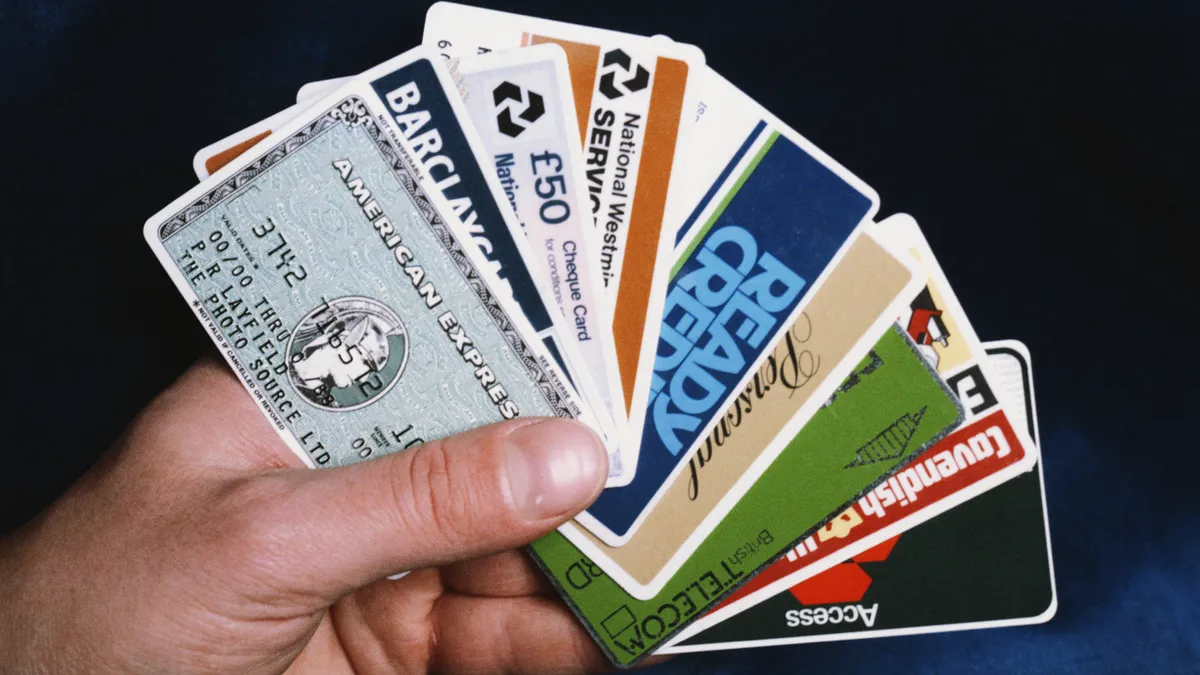Dive Brief:
- Overall consumer satisfaction with credit card issuers has continued to fall this year, piggybacking on the slide that began in March 2020 with the onset of the COVID-19 pandemic, according to the J.D. Power 2021 U.S. Credit Card Satisfaction Study released today. With midsize issuers showing the sharpest declines, the industrywide ratings on the 1000-point scale dropped to an average of 805 from 811 a year ago. The study covered the period from Sept. 2020 through June 2021.
- Customers across the board bristled at reductions in their credit limit precisely at a time they most needed access to their cards as a source of funds because of the impact from the deadly COVID-19 pandemic. Overall, 2% of card holders said their limits were reined in by the card companies. For midsize customers, the figure was 4% during the last part of the 2021 study, covering May and June.
- American Express and Discover held on to the top two spots, respectively, on the list of national issuers compared to a year ago. Meanwhile, Capital One rose to No. 3, swapping places with Bank of America which fell to No. 5. Among midsize issuers, Goldman Sachs took the No. 1 slot in its debut appearance on the rankings.
Dive Insight:
Goldman Sachs is making its first appearance on the list since entering the credit card business in 2019 in conjunction with a broader expansion into digital-banking services. Goldman issued its first card, the Apple Card, in August 2019. In January, General Motors switched its credit card partnership from Capital One to Goldman Sachs.
The Wall Street Journal reported in March that outstanding balances on Goldman’s credit cards totaled $4.3 billion as of December, more than double their level the year before.
Goldman’s eligibility for the rankings this year came about as a result of a change in the qualifying criteria to be included in the study, John Cabell, director of banking and payments intelligence at J.D. Power said in an email. J.D. Power had added smaller issuers to the study in 2019, dubbing the segment at the time as its “regional” category. To be eligible, these bank issuers had to have branches, which Goldman Sachs did not.
“As the market evolved and new entrants emerged, like Goldman Sachs, it became clear that the branch requirement was not really reflective of the direction of the industry, so we designated the segment ‘midsize’ and dropped the branch requirement,” Cabell said.
Meanwhile, the influence of fintech startups on the credit card landscape is becoming evident in the J.D. Power study now in its 15th year. The growing usage of mobile payments connected to cards and the emergence of BNPL (buy now-pay later) apps highlight the pressure on card issuers along with the tenuous state of customer satisfaction.
One-third of cardholders in 2021 are using mobile payment services with their card, according to the study. And satisfaction levels reported among these cardholders is up to 39 points higher than it is for customers who use the issuer’s mobile services.
While card companies recognize these are “unique and difficult times” for consumers, many issuers are missing the mark when it comes to meeting customers’ needs, Cabell acknowledged. “One of the biggest areas of opportunity is with supporting consumers through difficult financial times, where in the past year there was both growth in consumers reporting that situation and sharply declining satisfaction with the card experience with these same consumers.”
And what are the biggest pain points for customers? “Mostly it boils down to more cardholder challenges with problem resolution, long wait times for customer service, and changing rewards and credit limits that don’t align with cardholder usage and their financial stress," Cabell said.
J.D. Power research from July revealed customer preference for low- or no-interest BNPL installment loan service over a credit card. A reported 46% of retail shoppers using BNPL say they chose to avoid high interest rates and revolving debt associated with a credit card. “We’ve seen this BNPL product set eat into card spend in other markets, like Australia,” Cabell said. “The same phenomenon could develop over time in the U.S. as well.”
Other factors noted in the report contributing to card dissatisfaction relate to reward programs and specifically whether customers feel the cards they use reward them sufficiently or align with their spending patterns. Even though credit issuers have made grocery shopping and takeout dining expenses eligible for reward points, the study showed these changes were insufficient to boost satisfaction with reward earnings, which fell to 2019 levels.
The U.S. Credit Card Satisfaction Study included responses from 27,996 credit card customers from September 2020 through June 2021. It assessed six factors in measuring customer satisfaction: benefits and services; communication; credit card terms; Interaction; key moments (which refers to events such as fraud handling, card activation and replacement); and rewards.
While ranking eligibility is based on the number of active accounts and market share held by issuers, J.D. Power can’t disclose specific numbers under the terms of its agreement with the proprietary third-party source it uses to gather that information, said a company spokesman in an email. Issuers must have “open membership models” to be included. Broadly speaking, the credit card survey represents "at least the top two-thirds" of the market, said Cabell.










